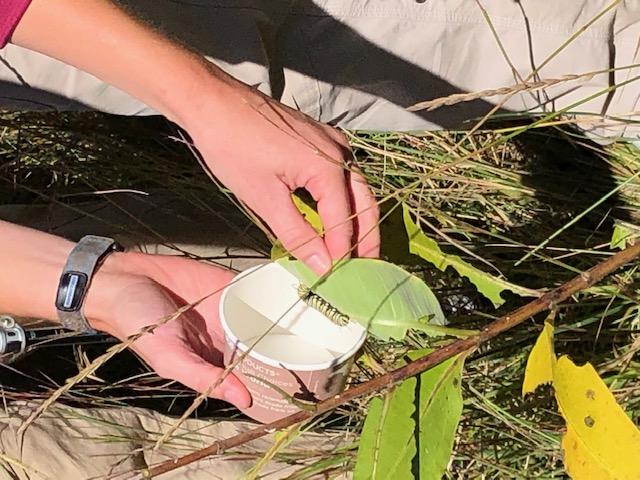- Tags:
- Recreation,
- Wildlife,
- Education

Thursday morning I met 21 residents of Havenwood Heritage Heights (HHH)at the Conservation Center floodplain for a naturalist tour of the trails. The weather was spectacular- not too hot and not too cold, with a blue sky and warm sun overhead. And, like the weather, the walk was spectacular too.
Havenwood Heritage Heights is a continuing care retirement community just up the street from the Conservation Center here in Concord. When I started in June as the Merrimack River Floodplain Education Coordinator, I knew one of my first priorities was to connect with our neighbors, so I reached out to HHH and offered to lead a nature walk for residents on the floodplain. I knew it was likely that there were new residents who were not familiar with our trails, and that I could point out things even regular visitors hadn’t noticed. And, it is important to us here that we increase people’s access to nearby nature, whether that is for our school-age kids or folks who graduated from school many decades ago (and everyone in between).
Because two of the residents who attended use a wheelchair and a walker, there was some pre-walk preparation to be done. Janet Zeller is a nationally-known advocate for increasing trail access to those with disabilities; she also is a resident of HHH and one of our Board members. She and I met one morning two weeks before the walk to test her wheelchair on the trails. We were both very pleased to find that she could traverse most of the trails on the property. We agreed that the walk should begin at our flat, wide emergency access road, rather than in the usual parking lot.
So, after some shuffling with the large excavator and dump trucks present doing their diligent work on a new culvert, the HHH bus dropped off the field trippers--with their hats, binoculars, hiking poles and field guides--ready for fun. We headed off into the woods and immediately noticed the plethora of mushrooms visible this time of year. Throughout the morning, we saw many different kinds of mushrooms, from the “Little Brown Mushrooms” so difficult to identify, to a large clump of yellow-capped Amanita mushrooms growing under a stand of oaks near the riverbank. I have watched these latter mushrooms pop up in different spots around these oaks over the last few weeks, and I am betting they have a significant mycorrhizal relationship with those trees. The oaks provide the fungus with photosynthesized sugars, and the fungi provide the trees with minerals they hunt in the soil. And I do mean hunt.
Two memorable moments came right along the riverbank. As we were standing looking at some old turtle egg shells next to a snapping turtle nest, a woman pointed to the sky and said, “What’s that?” It was a juvenile bald eagle that had been roosting in the trees nearby. As we watched, it flew away from us until it was just visible over the tops of the trees, where it caught a thermal and began to soar steadily upwards in circles, until it was almost out of sight.
The second moment was my favorite from the walk, and it happened while we stopped to investigate some milkweed. Our attention was caught by a striking black-and-orange milkweed tussock moth munching along the top of a large leaf. Eventually someone asked, “Do you ever see monarch caterpillars here?” In answer, I turned the leaf over to reveal a giant monarch caterpillar stretched out along the underside of the leaf, antennae waving obligingly.
This elicited a giant “Ooohh” from the whole group. No, I hadn’t planted that caterpillar (although I had seen it yesterday)- it was just the magic of nature aligned with a strategic Big Reveal. We shared a good laugh and then amazement at the migration biology of monarchs. These moments, and the entire morning, were a gift to experience for us all. Everyone left the walk agreeing that we needed to plan one for the spring. I’ll have to figure out what I can do for a Big Reveal next time.
